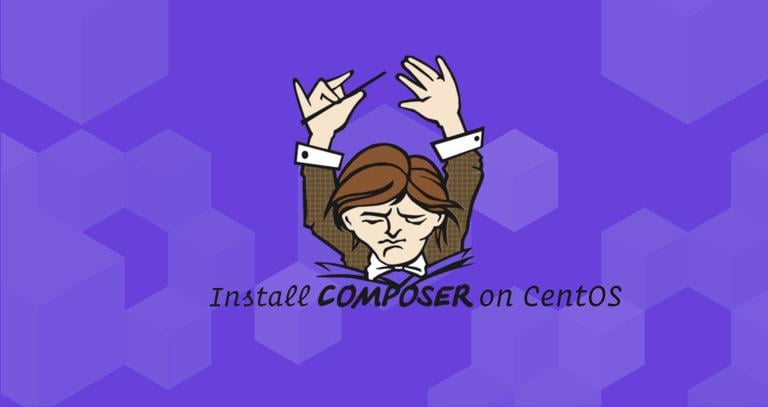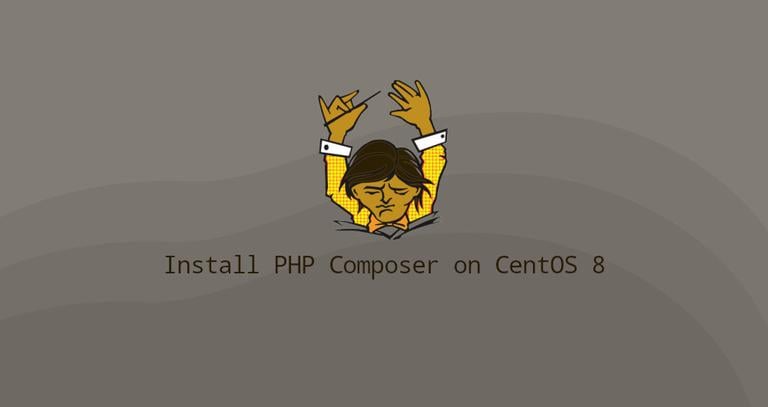How to Install and Use PHP Composer on CentOS 7
Updated on
•5 min read

Composer is a dependency manager for PHP (similar to npm for Node.js or pip for Python ).
Composer will pull in all the required PHP packages your project depends on and manage them for you. It is used in all modern PHP frameworks and platforms such as Laravel, Symfony, Drupal and Magento 2 .
In this tutorial, we will go through the steps of installing and using Composer on a CentOS 7 machine.
Prerequisites
Ensure that you have met the following prerequisites before continuing with this tutorial:
- Logged in as a user with sudo privileges
- Have PHP 7 installed on your CentOS 7 system.
Installing Composer on CentOS
The following steps describe how to install Composer on a CentOS 7 system.
First install the PHP CLI (command line interface) package and all other dependencies with:
sudo yum install php-cli php-zip wget unzipOnce PHP CLI is installed, download the Composer installer script with:
php -r "copy('https://getcomposer.org/installer', 'composer-setup.php');"The command above will download the
composer-setup.phpfile in the current working directory .To verify the data integrity of the script compare the script
SHA-384hash with the latest installer hash found on the Composer Public Keys / Signatures page.The following wget command will download the expected signature of the latest Composer installer from the Composer’s Github page and store it in a variable named
HASH:HASH="$(wget -q -O - https://composer.github.io/installer.sig)"To verify that the installation script is not corrupted run the following command:
php -r "if (hash_file('SHA384', 'composer-setup.php') === '$HASH') { echo 'Installer verified'; } else { echo 'Installer corrupt'; unlink('composer-setup.php'); } echo PHP_EOL;"If the hashes match, the following message will be shown:
Installer verifiedIf the hashes don’t match you will see
Installer corrupt. In this case, you need to redownload the Composer installation script and double check the value of the$HASHvariable withecho $HASH. Once the installer is verified, you can continue with the next step.Run the following command to install Composer in the
/usr/local/bindirectory:sudo php composer-setup.php --install-dir=/usr/local/bin --filename=composerAll settings correct for using Composer Downloading... Composer (version 1.8.5) successfully installed to: /usr/local/bin/composer Use it: php /usr/local/bin/composerThe
composeris installed as a system-wide command and it will be available for all users.The last step is to verify the installation:
composerThe command above will print the Composer’s version, commands, and arguments.
______ / ____/___ ____ ___ ____ ____ ________ _____ / / / __ \/ __ `__ \/ __ \/ __ \/ ___/ _ \/ ___/ / /___/ /_/ / / / / / / /_/ / /_/ (__ ) __/ / \____/\____/_/ /_/ /_/ .___/\____/____/\___/_/ /_/ Composer version 1.8.5 2019-04-09 17:46:47 Usage: command [options] [arguments]At this point, you have successfully installed Composer on your CentOS system.
php composer-setup.php which will create a file named composer.phar in your current working directory. You can use the composer by running ./composer.phar <command>.Getting Started with Composer
Now that Composer is installed on your CentOS system we will show you how to use Composer in a PHP project.
Start by creating a directory that will be the project root directory and hold the composer.json file.
composer.json file describes your PHP project including the PHP dependencies and other metadata.
Create the project directory and switch to it with:
mkdir ~/my-first-composer-projectcd ~/my-first-composer-project
In this example, we will create a sample application that will print the current time using a package called carbon .
Run the following command to initialize a new Composer project and install the carbon package:
composer require nesbot/carbonUsing version ^2.2 for nesbot/carbon
./composer.json has been created
Loading composer repositories with package information
Updating dependencies (including require-dev)
Package operations: 3 installs, 0 updates, 0 removals
- Installing symfony/polyfill-mbstring (v1.9.0): Downloading (100%)
- Installing symfony/translation (v4.1.4): Downloading (100%)
- Installing nesbot/carbon (2.2.0): Downloading (100%)
symfony/translation suggests installing symfony/config
symfony/translation suggests installing symfony/yaml
symfony/translation suggests installing psr/log-implementation (To use logging capability in translator)
Writing lock file
Generating autoload files
As you can see from the output above Composer will create the composer.json file and it will download and install carbon and all its dependencies.
If you list your project’s directory
, you will see that it contains two files composer.json and composer.lock, and a vendor directory.
ls -l-rw-r--r-- 1 linuxize users 60 Aug 29 00:50 composer.json
-rw-r--r-- 1 linuxize users 6.8K Aug 29 00:50 composer.lock
drwxr-xr-x 5 linuxize users 4.0K Aug 29 00:50 vendor
- The
vendordirectory is the directory where the project dependencies are stored. - The
composer.lockcontains a list of all installed packages including their versions. - The
composer.jsondescribes the PHP project and all PHP dependencies.
Composer provides autoload capabilities which allow us to use PHP classes without the need to use require or include the files.
Create a file named testing.php and add the following code:
<?php
require __DIR__ . '/vendor/autoload.php';
use Carbon\Carbon;
printf("Now: %s", Carbon::now());
Let’s analyze the code line by line.
In the first line after the opening php tag we are including the vendor/autoload.php file that was automatically generated by Composer which will autoload all of the libraries.
Next, we are aliasing Carbon\Carbon as Carbon and in the last line we are printing the current time using the Carbon now method.
Run the script by typing:
php testing.phpThe output should look something like this:
Now: 2018-09-26 20:08:18
Later on, if you want to update your PHP packages you can simply run:
composer updateThe command above will check for newer versions of the installed packages and if a newer version is found and the version constraint
match with the one specified in the composer.json, Composer will update the package.
Conclusion
You have learned how to install Composer on your CentOS 7 machine. We have also shown you how to use Composer to create a basic PHP project.
To find more information about Composer, visit the official Composer documentation page.
If you have any questions, please leave a comment below.


